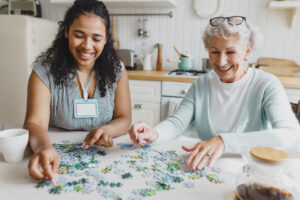Many people genuinely like being with older adults, and take great joy in their companionship. Interacting with them comes easily and naturally, turning time spent together in a productive relationship. But what do you do when a person is only beginning to learn how to interact with others, let alone older adults? What if the person is a child or teen?
Relating well to older adults takes special knowledge and skill. Read on to see how seniors and kids can socialize in a meaningful way – and how to teach related skills to your children.
Grade school (up to age 10)
Younger children often have a special relationship with one or more of their grandparents. Many times, they see them as an extension of their own mom or dad. It’s during this period of life that a crucial bond is formed. The kids are eager to show their grandparents their pictures, toys, stuffed animals, video games, or whatever else they happen to be interested in at the moment.
Unfortunately, what they don’t understand is that it’s often difficult for older adults to keep up with such unbridled enthusiasm. Explain to your kids that grandma or grandpa may not be able to run with them in park all afternoon, or that they need frequent breaks. You may also have to tell them that they can’t do certain activities because their grandparents have conditions like arthritis. Make sure they know to speak loudly and clearly if the older adult has some hearing loss. They may also need to describe things instead of showing them due to the older adult’s low vision.
Tweens (ages 11-12)
At this age, grandchildren usually start developing their own social lives, and are less inclined to see their grandparents as cool. Of course, we know the latter isn’t true, but the kids may need some convincing!
See what activities your tween can do with their grandparents that are based on mutual interests. In an age where more older adults are becoming computer savvy, this can be a great way to increase communication with their grandkids — even when they can’t be with them face to face.
Also, this is a great time for tweens to begin volunteering at a retirement center, nursing home, or assisted living facility. In addition to seeing some of the challenges older adults face, the tween can listen to stories about their lives. Ideally, they will walk away with a better understanding of the residents as individuals — not just folks in a category called “old.”
Teens (ages 13-18)
Ah, the teenage years! This is when your son or daughter’s time is likely to be at a premium. Between school, part-time jobs, and socializing, spending time with grandparents gets pushed to the back burner. But as with the “tweenage years,” computer and social media can help keep them connected.
At this point, it’s a great idea to make visiting the grandparents a full-fledged family activity. Your teen may moan about it at first, but mandatory quality time may be the only way you ever get them and their grandparents together. Focus on activities that everyone can do, such as having a picnic, spending a day at the beach, or even going to a drive-in movie.
If your teen continues to balk, remind them that the older adults in their lives won’t be around forever. Unlike those must-see Tumblr posts or constant twitter updates, their window for being with their loved ones is finite. Ask the older adults to share stories of what it was like when they were the teen’s age. Your teen may begin to see them not as someone “past their prime,” but a person who has weathered storms that they themselves may one day experience.
Seniors and kids: perfect together
Seniors and kids (especially grandparents and grandchildren) often have a unique relationship. Now that someone else is responsible for the main parenting duties, grandparents may feel calm around their grandkids. This lets them enjoy purely recreational time together. Children sense this peaceful energy (and often the relaxed rules that go with it!), and respond accordingly. By putting this natural bond together with the techniques above, seniors and kids can keep each other young at heart for years to come!
If you are unsure of how to best help an aging loved one, the trained and compassionate staff at the Institute on Aging is here to help you make that decision and gain the best in at-home care for older adults. Contact us to find out more.







